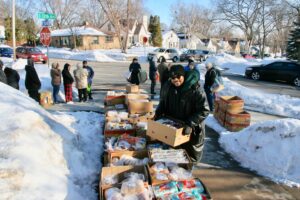
Pastor Darrick Granison, ready to share food at New Creations church Monday food shelf
BY STEPHANIE FOX
It’s another frigid Monday afternoon in mid-March and the lines of people are already beginning to form outside of New Creations Ministries, a South Minneapolis church at the corner of 51st Street and 13th Avenue. It’s an hour before the food shelf opens to the public. Senior Pastor Darrick Granison, his wife Brenda (known as the First Lady), along with a group of volunteers are getting ready, setting out boxes of free food for the church’s weekly food shelf. Granison hopes that the food they provide will last families for at least three days.
Their mission is to provide access to healthy food for people faced with missing meals. No one coming is forced to prove that they are in need. Simply show up and you’ll be welcomed.
There has always been a need for food for those who are down on their luck, but COVID-19 made that need worse as jobs disappeared when businesses closed to prevent the spread of the disease.
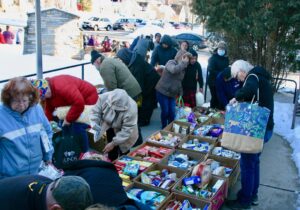
Lines of people come to get food at New Creation’s food shelf.
“We’ve seen the numbers almost double across the state,” said Colleen Moriarty, the executive director of Hunger Solutions, an advocacy group concerned with food security. People got emergency funding during the worst of the pandemic but after much of the government support ended, the number of people visiting food shelves around the Twin Cities and the rest of the state skyrocketed. There are now more than 500 food shelves in Minnesota.
“Minnesotans made 5.5 million visits to food shelves in 2022, according to the latest figures available,” Moriarty said. “That’s 1.9 million more visits than in 2021.”
Promptly at 5:30 p.m. the doors at New Creations opened. Announcements are made in English and Spanish. The first group invited to collect from the boxes of food lining the walkway leading to the church doors are those aged 70 and older. “We don’t want to burden them and 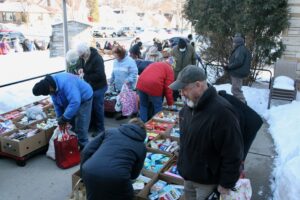 make them have to stand so long waiting,” said Granison. “And many don’t move as fast as younger people. The past week, a couple of people who came were in wheelchairs and used crutches.”
make them have to stand so long waiting,” said Granison. “And many don’t move as fast as younger people. The past week, a couple of people who came were in wheelchairs and used crutches.”
Granison says he was motivated as a young boy to help others. “We’ve been doing the food shelves for 12 years,” he said. “As a little boy, my family was struggling. My dad would take us to a soup kitchen, and we’d get our clothes from the Salvation Army.”
Loss of income, losing a family breadwinner to the pandemic, and rising food prices are some of the reasons that people who once could buy enough on their own now come to food shelves. “We serve all sorts of people,” said Granison. “People who come are Hispanic, white, African and African American. We even have Ukrainians. If we can help you not have to spend so much money on food, we are here to help eliminate some of that burden.”
On that chilly March day, New Creations gave out 208 boxes of food, more than 32,000 pounds. Inside, 100 boxes designed so families could make full meals waited inside the church basement.
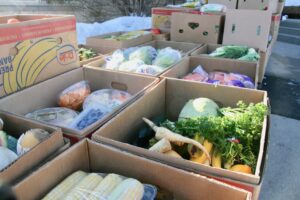
Boxes of food wait for those in need.
Just a couple of miles from New Creations Church another food shelf is helping distribute food to those in need. Minnehaha United Methodist Church distributes food on Tuesday afternoons. Sara Olson, who coordinates the food shelf, says that many of their clients are newly arrived immigrants from Ecuador. That situation has caused unique problems.
“Many of these people are from the rural areas of Ecuador,” she said. “They dress in traditional clothing, and we hear a lot of Indigenous languages. We are searching for volunteers who speak Spanish and can help translate.”
“Since January 2022, our client list has nearly tripled,” Olson said. “In June 2022, we saw 1,020 clients. That’s when the numbers started going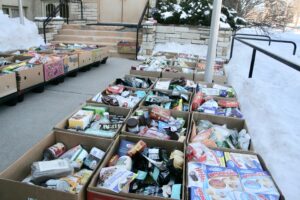 up. Last December, we saw 2,792 and this January, we served 3,175 people. We get more and more people all the time. We open from 10 a.m. until 3 p.m., but people start lining up at 5:30 in the morning.”
up. Last December, we saw 2,792 and this January, we served 3,175 people. We get more and more people all the time. We open from 10 a.m. until 3 p.m., but people start lining up at 5:30 in the morning.”
“The thing is,” she said, “if you come early you get a choice of everything we have. People go through the fresh stuff, pre-packed fresh fruits and vegetables. People also want dried beans and rice, so we try to get these kinds of foods, not the processed foods that many Americans are eating.”
People who come to the church need to show some kind of ID with their address but can live anyplace in the metro area. “People come from Brooklyn Park, Bloomington, but most come from South Minneapolis. There are always hungry people, so giving out free food is always useful in a community,” Olson says. “The USA is not always able to provide for its citizens. The problem of hunger is here and in most American cities.”
New Creations Church gets much of their donated food from Kowalski’s, Cub Foods, Aldi, Lunds & Byerlys and Fresh Thyme grocery stores, as well as buying discount groceries from organizations like Second Harvest, a hunger-relief organization. New Creations also accepts donations of food and money from individuals who want to help.
“One thing that we do is that we pull our products before they are expired,” said Kowalski’s Parkview Market’s assistant manager Luanne Schroeck. “Things like fresh produce, fresh bakery and deli items. We have people from several food-sharing organizations who pick up donations every day. It’s just a way to create sustainability in the neighborhood for those who are struggling,” she said.
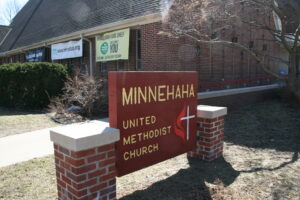
Minnehaha United Methodist Church
While many emergency food shelves are church-operated, many others are run by community-based organizations including the Teamsters, the Salvation Army, Waite House, the Division of Indian Work, the Aliveness Project, the Center for Asians and Pacific Islanders and more. There are more than 55 food shelf locations in Minneapolis alone, not including places that provide free meals to those who would otherwise go hungry.
“Now that the food aid is getting cut back more and more, I think we’ll be getting more and more people,” said Olson. “We’re becoming almost a political organization, working on how to get money and to pay to keep everything going. This is a basic need and it’s appalling to me that money is not going to human needs.”
With the need still growing, the Minnesota Legislature recently passed additional funding going directly to food shelves to stem the financial pressure they are currently facing. Gov. Walz signed a bill to provide $5 million in emergency funds to the Minnesota Food Shelf Program, which provides grants to food shelves that are part of the Minnesota Emergency Food Assistance Program. The bill passed the House with a unanimous vote. In the Senate, seven members of the GOP delegation voted against the bill. The funding will help rescue many organizations, say people who work at food shelves.
“No one should ever go hungry in Minnesota. To address the food insecurity that some Minnesota families face, we are taking action to ensure that Minnesotans can put food on their tables and don’t have to choose between food and other essential bills to pay,” said Rep. Emma Greenman, who serves a district in South Minneapolis. “This year we have passed laws to ensure that Minnesota food shelves are stocked with enough food to meet the needs of their communities and to feed every Minnesota school kid.”
Food shelves still need volunteers and donations from the public, both money and goods, including healthy food, diapers, toothpaste and deodorants, women’s products and other essentials, said Granison. “Food shelves are here to serve the community. If you know anyone who can donate or who needs a food shelf, spread the word. We turn no one away.”






















